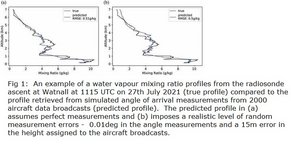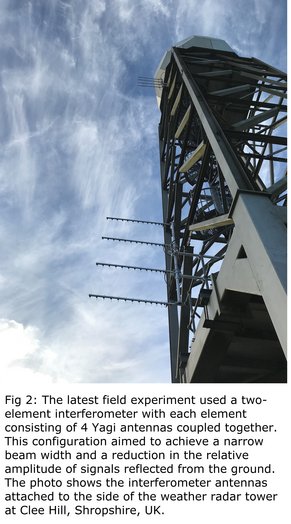Update from the 2019 Prize Winners – A New Method of Measuring Atmospheric Refractivity
Since the previous update, the following progress can be reported:
- A PhD student, Ollie Lewis, was successfully recruited to work mainly on data exploitation aspects of the new technique. His PhD has been funded by the H-O prize money, Exeter University and the Met Office. Ollie is now in his third year and, at the time of writing, has approximately 15 months of study time remaining.
- A joint Met Office/Exeter University team has been established to guide the project that includes experts in the established GPS-RO refractivity retrievals, which is similar to the new technique in that the basic measurement is of bending angle.
- Ollie has published a paper on the modelling work (Lewis et al, 2023a) and won the prize for the best student paper presented at a recent SPIE conference (Lewis et al, 2023b)
- Refractivity profiles have been retrieved from the bending angles of radio signals broadcast by civil aircraft over ~ hour-long periods in small azimuth sectors close to the horizon. Different retrieval methods have been tested using both real and simulated angle of arrival data. The simulations have also been used to explore the sensitivity of the technique to different levels of measurement accuracy (see Fig 1 below).
- Four field experiments have been carried out using different configurations of the interferometer antennas. (see Fig 2 below)
- Incremental progress has been made in improving the accuracy of the angle of arrival of the radio signals measured by the interferometer. Sensitivity studies have shown that an accuracy of 0.01deg will be required to be able to resolve hour-to-hour changes in atmospheric refractivity profiles. The initial design of the interferometer achieved an accuracy of ~0.1deg, but improvements since in the antenna and signal processing have reduced the errors to ~0.03deg for the most recent field experiment. The main limitation now seems to be signals reflected from topography which interfere with the signals following the direct path from the aircraft. The mutual interference reduces the correlation between the signals received at the two interferometer elements and introduces errors in the angle of arrival determination.
- The problem with ground reflections is now seen as the major obstacle to a successful implementation. With this in mind, funding is being sought for a project to design a bespoke antenna optimised for this application. This related project would be a collaboration with Bath University’s Department of Electrical and Electronic Engineering.
Malcolm Kitchen and Chris Brunt, December 2023
References
Lewis, O., Brunt, C. M., and Kitchen, M., 2023a. A New Method of Retrieving Atmospheric Refractivity Structure, Int. Journal of Remote Sensing, 44, p749-785. https://www.tandfonline.com/doi/abs/10.1080/01431161.2023.2170192
Lewis, O., Brunt C., Kitchen, M., Healy, S., and Bowler, N. 2023b. A New Method of Retrieving Atmospheric Refractivity. Proc. Vol 12730. Remote Sensing of Clouds and the Atmosphere XXVIII SPIE Remote Sensing, 3-6th Sept 2023, Amsterdam, Netherlands. https://doi.org/10.1117/12.2672221


